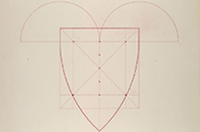Ruskin's Rudimentary series, 3rd ed. (1872)
Items marked 'M' are drawings "by my own Hand" (by Ruskin), P are photographs, E engravings and A by Ruskin's Assistant, Arthur Burgess.

Ruskin's Catalogues: 1 object
Show search help- Reference URL
Actions
Study of the Marble Inlaying on the Front of the Casa Loredan, Venice John Ruskin
-
Ruskin text
R|22} Study of the marble inlaying on the front of Casa Loredan, Venice (1845). M. -
Details
- Artist/maker
-
John Ruskin (1819 - 1900)
- Object type
- drawing
- Material and technique
- watercolour, bodycolour and pen and ink over graphite on pale grey wove paper
- Dimensions
- 342 x 297 mm
- Associated place
-
- Europe › Italy › Veneto (Venetia) › Venice › Palazzo Loredan › Palazzo Loredan (subject)
- Inscription
- Recto, bottom, towards right, in ink: Casa Loredan
Verso:
left, below centre, in ink, upside down: 114
to the right of and below centre, in graphite: R. 22
bottom left, the Ruskin School's stamp
- Provenance
-
Presented by John Ruskin to the Ruskin Drawing School (University of Oxford), 1875; transferred from the Ruskin Drawing School to the Ashmolean Museum, c.1949.
- No. of items
- 1
- Accession no.
- WA.RS.RUD.022
-
Subject terms allocated by curators:
Subjects
-
References in which this object is cited include:
References
Taylor, Gerald, ‘John Ruskin: A Catalogue of Drawings by John Ruskin in the Ashmolean Museum, Oxford’, 7 fascicles, 1998, Oxford, Ashmolean Museum, no. 025
Ruskin, John, The Ruskin Art Collection at Oxford: Catalogue of the Rudimentary Series, in the Arrangement of 1873, ed. Robert Hewison (London: Lion and Unicorn Press, 1984), cat. Rudimentary no. 22, RUD.022
Ruskin, John, Instructions in Practice of Elementary Drawing, Arranged with Reference to the First Series of Examples in the Drawings Schools of the University of Oxford (n.p., [1872]), cat. Rudimentary no. 22
Ruskin, John, Instructions in the Preliminary Exercises Arranged for the Lower Drawing-School (London: Smith, Elder, 1872), cat. Rudimentary no. 22
Ruskin, John, Instructions in the Preliminary Exercise Arranged For the Lower Drawing-School (London: Spottiswoode, 1873), cat. Rudimentary no. 22
Ruskin, John, ‘Rudimentary Series 1878’, 1878, Oxford, Oxford University Archives, cat. Rudimentary no. 22
Ruskin, John, ‘The Ruskin Art Collection at Oxford: Catalogues, Notes and Instructions’, Edward T. Cook and Alexander Wedderburn, eds, The Works of John Ruskin: Library Edition, 39 (London: George Allen, 1903-1912), 21, cat. Rudimentary no. 22
Location
-
- Western Art Print Room
Position in Ruskin’s Collection
Ruskin's Catalogues
-
Ruskin's Rudimentary series, 3rd ed. (1872)
R|22} Study of the marble inlaying on the front of Casa Loredan, Venice (1845). M. -
Ruskin's Rudimentary series 4th ed. (1872)
R|22} Study of the marble inlaying on the front of Casa Loredan, Venice (1845). M. -
Ruskin's Rudimentary series, 5th ed. (1873)
R|22} Study of the marble inlaying on the front of Casa Loredan, Venice (1845). M. -
Ruskin's revision to the Rudimentary series (1878)
remains 22.Placed here to show the proper treatment of heraldry in sculpture. The building is of three dates: its capitals, and the arches they bear, are Byzantine; the shields and casque, inlaid with modifications of the earlier work, presumably in the Fifteenth Century; the balustrade above barbarous Seventeenth. But nothing could surpass the beauty of the whole when I made this sketch in 1845; the lovely wild weeds being allowed to root themselves in the sculptures. Although I did not in 1845 know how to paint, the extreme fault of this and other drawings of mine at the time are owing to the fact that I was always working, not for the sake of the drawing, but to get accurate knowledge of some point in the building - which knowledge I always expressed securely first with the pen, however hard or bad the effect might be afterwards. Thus here I R. wanted the curves of the shield and casque, and the exact relief and method of their decoration. If you will look with a magnifying-glass at the bit of foliage in the front of the casque and at the door and window of the castle that surmounts it, you will see that the accuracy with which these are drawn was wholly incompatible with picturesque effect unless I had been John Lewis, instead of John Ruskin, and given my life to such work. But the pieces of yellow leafage above are freely and rightly painted, first with Chinese-white and then glazed. The bit of Oxford weed below is well indicated in form, though left too green in colour from mere hurry, and it will do any student good, in early stages of colour-study, to copy this casque with the leaves above and the two shields at each side of it. Of course the rest of the drawing is miserably hurried.





